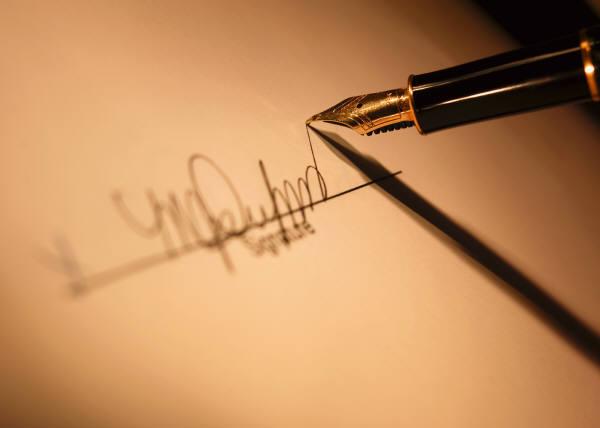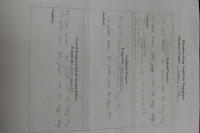History
Interest in handwriting analysis has been around since 1633. Scientists, philosophers and artists have always sparked interest in the relationship between writers and their handwriting. Efforts in analysis of handwriting began when the French abbe Hypolite Michon began his work in 1872, giving handwriting analysis the name graphology. He and his compatriot Jules Crepieux-Jamin developed a school that attempted to relate the isolated signs of specific handwriting elements to certain human traits. Though the process was drawn out over a long period of time, in 1910 a shorthand teacher by the name of Milton Newman Bunker began analysis that led to a unique discovery. He was curious as to why he had put wide spaces between his letters and long finals on his words when he was a penmanship student which inspired him to indulge in studies of graphology. Later in 1915 he recognized that each of his students formed shorthand strokes in a particular manner, and after making this observation he quickly realized that it was not the letter which had a trait, it was the strokes. Graphology supports the theory that O’s with an open top indicate a person who writes in this manner is someone who speaks very openly and often, and after making more observations Bunker realized the personality traits were correct and the handwriting traits also applied to the letters a, g, d, and q. Thousands of miles traveled, thousands of people interviewed, and more than half a million handwriting specimen analyses later, Milton Newman Bunker established graphoanalysis, the copyrighted American System of handwriting analysis, which is still used today.


12 Handwriting Characteristics
There are twelve defining characteristics of handwriting:
- Line Quality
- Spacing of Words
 Spacing of Letters
Spacing of Letters- Pen Lifts
- Word Separations
- Connecting Strokes
- Unusual Letter Formation
- Slant
- Baseline Habits
- Flourishes
- Embellishments
- Didactic placement
These characteristics help forensic experts identify forgeries every day. What are your handwriting characteristics?
http://www.clt.uwa.edu.au/__data/page/112506/fsp10_handwriting.pdf
http://handwritinguniversity.com/barackobama/
http://handwritinguniversity.com/barackobama/
Handwriting Analysis
Forgeries can be created in two ways: freehand and tracing. Freehanded forgeries are created when a person studies the characteristics of another’s handwriting and tries to replicate the style themselves. Tracing forgeries consist of using a piece of parchment to cover an original document scribed by the person whose handwriting is being attempted to replicate and tracing the words from the original document to the parchment used to write the forgery. Forgery style choice can depend on the artistic level of the forger. Tracing provides more accurate results when attempting to replicate the exact characteristics of the words, but free hand provides more vocabulary choices when creating forged documents. Even if the forgeries are very similar, they will not be exactly like the original handwriting style. Everyone has a unique writing style; no two people have the same characteristics!

Isaac Bear’s Biology class completed a handwriting analysis activity in which students were instructed to forge their classmates’ signatures. My personal forgery style preference was freehand due to the unclear view of the words and style of my classmate’s handwriting when being traced. I found it easier to write it myself when having a clear observation of the work I was to replicate. When tracing I was conscientious of the twelve handwriting characteristics and noticed that Cosette Taggart (http://ctaggartforensics.blogspot.com/), my classmate, had very large loops on her y’s and f’s when writing in cursive and a slight right slant. The activity was a fun way of learning about different writing styles and I have learned to observe the style of my classmates’ handwriting and my own.
Check Forgery Activity
One of the activities we completed in class involved check forgery. Mr. Kelly, the Biology teacher, printed fake checks for each of the students to fill out. Once filled out the students were instructed to rip the checks into pieces and place them in an envelope. The students shuffled them amongst their groups and put the pieces back together, trying to identify whose handwriting it was. After everyone identified the owner of their check they discussed how the handwriting characteristics helped them identify their classmates.
My group consisted of three other students: Cosette Taggart, Marissa Morrison (http://mmorrisonforensics.blogspot.com/), and Bradley Caison (http://bcaisonforensics.blogspot.com/). Together we were able to identify each other’s handwriting styles based on the twelve handwriting characteristics discussed in class. Embellishments, didactic placement, and slant were some of the most helpful characteristics for our group. We all enjoyed this activity and if it were to be assigned again we would like to engage in a class discussion about the different characteristics of each student.
Check forgery picture taken by Marissa Morrison. Rotation of picture was unavailable.Famous Forgery Case
One famous case of forgery occurred in 1985 involving Mark Hofmann, a double murderer from Utah, USA, who forensic experts consider to be one of the best forgers they’ve caught yet. Hofmann had forged many Mormon documents and began selling church collections for self-benefit, but once his plans began to stop working he created bombs and murdered two people in an attempt to lead his plans back in the right direction. Forensic history was made when authorities caught Hofmann for his forgeries during the murder investigations when detectives found Hofmann’s method for forging documents was chemically aging ink and applying it to old paper. Bound by trial for over thirty felonies, Mark Hofmann decided to plead guilty to the two murders caused by his bombs and by doing so all other charges were dropped, and he was put in jail in 1987. He was sentenced to five-years-to-life in the Utah State Penitentiary with possible Parole after seven years, but when making threats against the Board of Pardons he lost his chances of gaining Parole. Mark Hofmann unsuccessfully attempted suicide twice while incarcerated and is still in prison serving his life sentence today. Forensics always serves justice!


This is really informational Amanda! But again, I think that you should add some more pictures such as those from your forgery activity.
ReplyDeleteJust add more pictures of the activity and then it will be fine.
ReplyDeleteI like how in-depth you explain everything, and you make it easy to understand! Awesome!
ReplyDeleteThe Graphology School of India (GSI) was set up in conjunction with The International School of Handwriting Analysis (ISHA) by Mrs. Pradeep K.U in 2011, to establish a firm base for Handwriting Analysis in Bangalore. The college is an independent teaching body, offering training courses in Handwriting Analysis. The GSI offers courses are Beginners Diploma, Comprehensive Course, Evaluated Traits Course, and Master (SSS) Course.
ReplyDeleteHandwriting Analysis
Thanks for sharing this informative blog : Document examination training
ReplyDelete